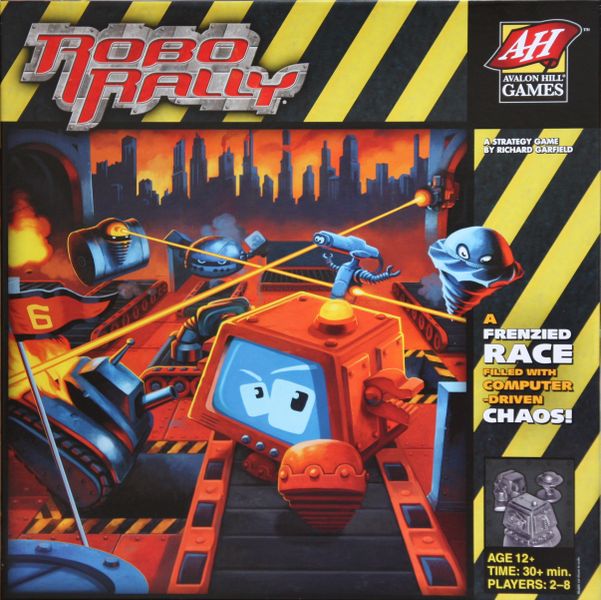RoboRally, designed by Richard Garfield and released in 1994, is a classic board game that combines elements of racing, strategy, and chaos. Published by Wizards of the Coast, the game has gained a cult following over the years for its unique gameplay mechanics and engaging player experience.
Game Components of RoboRally
Robot Figures: 6-8 pre-painted or metal robots depending on the edition.Player Mats: 8 robot player mats for each player.Game Boards: Varying sizes and numbers of boards across editions (e.g., 6 12×12 boards in the 1995 edition, 4 10×10 boards in the 2016 edition).Programming Cards: 160 cards (8 decks of 20 cards each) for programming robot movements.Damage Cards: 54 cards that introduce chaos and penalties.Upgrade Cards: 40 cards that allow for improvements and special abilities.Tokens and Markers: Energy tracking cubes, reboot tokens, archive tokens, checkpoint tracking tokens, and priority tokens.Miscellaneous: Large player aid cards, rulebook, and sticker sheet.
How To Setup RoboRally
Setting up RoboRally involves several steps:
Each player chooses a robot figure and places it on the starting space on the board.Players receive their player mat and a set of programming cards.The game boards are arranged according to the specific edition’s rules.Upgrade and damage decks are shuffled and placed within reach of all players.Each player starts with a set amount of energy and uninstalled upgrade cards.The priority token is determined, which can vary by edition (e.g., priority cards in older editions, first player token in newer editions).
Gameplay Mechanics and Game Objective
Programming Phase: Players program their robots by selecting and arranging a set of movement cards (typically 5 cards per round).Execution Phase: Players reveal and execute their programmed actions in turn order.Board Activation: After each card phase, the board elements (like conveyor belts, lasers, and pushers) activate, potentially moving or damaging robots.Upgrade Phase: Players can spend energy to install upgrades or draw new ones.Objective: The goal is to be the first robot to touch all checkpoints in the correct order and return to the starting point.
Player Experience
Playing RoboRally is a chaotic and fun experience, combining strategic planning with unpredictable outcomes. Players must carefully program their robots’ movements, anticipating how the board elements and other robots will interact. The game is known for its social aspect, as players often find themselves laughing at the misfortunes of their robots and the unexpected twists that arise from the game’s mechanics.
Pros
Strategic Depth: Requires careful planning and foresight.Social Interaction: Encourages laughter and engagement among players.Dynamic Gameplay: Each game can be significantly different due to the random board elements and player interactions.Easy to Learn: Simple rules make it accessible to new players.
Cons
Unpredictable Length: Games can vary significantly in length due to the randomness of the damage deck and board interactions.Complex Damage System: Managing damage and SPAM cards can be frustrating and complex.Edition Variations: Different editions have distinct rules and components, which can be confusing for new players.
Personal Thoughts on RoboRally
RoboRally is ideal for groups of friends looking for a fun, light-hearted game with a mix of strategy and chaos. It serves as an excellent gateway game for those new to board games beyond Monopoly, introducing them to programmed movement and strategic planning. However, the game’s complexity and variability in different editions might make it less appealing to those seeking a highly streamlined or serious gaming experience. If you’re looking for the original feel with simpler rules, the 1995 or 2005 editions might be more to your liking, while the newer editions offer refined mechanics but with some added complexity.
We are supported by our audience. When you purchase through links on our site, we may earn an affiliate commission, at no extra cost for you. Learn more.

